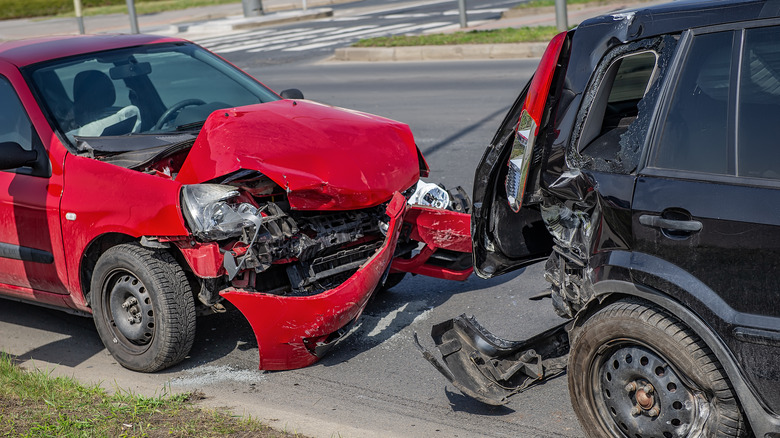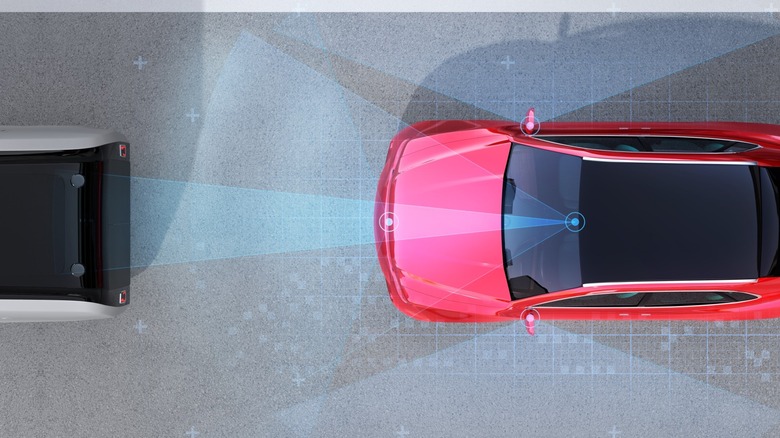
Den Rozhnovsky/Shutterstock
Helping to avoid or minimize potential rear-end collisions is the main benefit of Automatic Emergency Braking (AEB) for the average driver. While it has not yet been mandated as standard equipment on all new vehicles, the U.S. Department of Transportation’s National Highway Traffic Safety Administration (NHTSA) proposed a rule in May of 2023 to require AEB on all passenger cars and light trucks. AEB is a high-tech safety system that is currently available in the vast majority of new vehicles, as well as on many used vehicles. NHTSA estimates that if AEB were mandated in all of these vehicles, at least 360 lives would be saved each year, along with the prevention of 24,000 injuries, not to mention huge reductions in property damage from all of those rear-end collisions that simply would not happen.
Accidents that result from drivers running into the rear of the cars ahead of them are a huge problem. These accidents occur frequently, they cost a lot to repair, and they cause major damage to both of the vehicles involved. Rear-end accidents can also have a high human cost in terms of injuries, high medical costs, pain and suffering, and even fatalities. By reducing the number of these types of collisions, AEB technology can have many beneficial effects on society.
What is Automatic Emergency Braking?

Stanislav Duben/Shutterstock
Automatic Emergency Braking is an Automated Driver Assistance System (ADAS). When your car is equipped with AEB, it has the ability to slow down or stop your car autonomously if it senses a potential accident. AEB can do this without any action on your part. Most vehicles with AEB have it in the front, where it works to prevent you from running into vehicles, pedestrians, or cyclists ahead of you. According to research done by Bosch, a major industry supplier of AEB components, up to 72% of rear-end collisions that involve personal injuries could be avoided with AEB. Some newer front AEB systems can also protect you from turning left into the path of an oncoming vehicle.
More and more newer vehicles also come with rear AEB, which may be called Rear Cross Traffic Alert (RCTA) or something similar. Vehicles with RCTA will protect you from backing into the path of another vehicle by applying the brakes. This is a very handy feature to have in a crowded parking lot, where other vehicles may not see you backing out.
How does Automatic Emergency Braking work?

Chesky_w/Getty Images
An Automatic Emergency Braking system uses software and sensors, which may be radar, cameras, or a combination of technologies to constantly monitor the area in front of your vehicle. The AEB system’s computer also tracks your vehicle’s speed relative to your distance from the vehicles ahead. If the system observes that the distance between you and the traffic ahead is getting too short and indicates a potential accident, or if a person or bicycle appears in front of you, AEB will activate the brakes if you don’t respond to the situation. You will also receive an audible warning and see a warning light illuminate on the dashboard.
Rear AEB or Rear Cross Traffic Alert (RCTA) works in a similar way but is designed for the type of low-speed operation you will normally experience in parking lots and similar situations. RCTA works particularly well in situations where you are backing up, in which it will prevent you from reversing into another parked car, a pole, a pillar, or even into the path of an approaching vehicle you may not see.
AEB has some limitations

Gorloff-KV/Shutterstock
AEB is not perfect and does come with some limitations. There can be false alerts due to glare, reflections, road shadows, cars parked along a curve in the road, or vehicles driving in an adjacent lane. Some sensors may not work well in rain, fog, or snow. Sensors can also get blocked by ice or snow accumulation, preventing them from “seeing” properly.
When you are driving in rainy, snowy, or icy conditions, braking distances will be much longer, which means that your AEB system will require more distance to stop your vehicle and prevent an impact. In the event that you do have a rear-end accident, your repair costs will be higher, thanks to all those AEB sensors that may need replacement!
It is important to understand that AEB is not guaranteed to prevent rear-end collisions. It is not a substitute for paying attention to the road as you drive. It is simply an additional system to help keep you safe, much like the seatbelts and airbags in your vehicle. Despite these limitations, AEB is still one of the best driver aids available. In terms of its ability to prevent rear-end accidents, along with the damage and injuries that usually result, it is definitely a safety feature that your next car should have.
